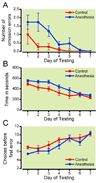Rats exposed to isoflurane in utero during early gestation are behaviorally abnormal as adults
- PMID: 21307768
- PMCID: PMC3071297
- DOI: 10.1097/ALN.0b013e318209aa71
Rats exposed to isoflurane in utero during early gestation are behaviorally abnormal as adults
Abstract
Background: Preclinical evidence suggests that commonly used anesthetic agents induce long-lasting neurobehavioral changes when administered early in life, but there has been virtually no attention to the neurodevelopmental consequences for the fetus of maternal anesthesia. This study tested the hypothesis that fetal rats exposed to isoflurane during maternal anesthesia on gestational day 14, which corresponds to the second trimester in humans, would be behaviorally abnormal as adults.
Methods: Timed, pregnant rats were randomly assigned on gestational day 14 to receive 1.4% isoflurane in 100% oxygen (n = 3) or 100% oxygen (n = 2) for 4 h. Beginning at 8 weeks of age, male offspring (N = 12-14 in control and anesthesia groups, respectively) were evaluated for spontaneous locomotor activity, hippocampal-dependent learning and memory (i.e., spontaneous alternations, novel object recognition, and radial arm maze), and anxiety (elevated plus maze).
Results: Isoflurane anesthesia was physiologically well tolerated by the dams. Adult rats exposed prenatally to isoflurane were not different than controls on spontaneous locomotor activity, spontaneous alternations, or object recognition memory, but made more open arm entries on the elevated plus maze and took longer and made more errors of omission on the radial arm maze.
Conclusions: Rats exposed to isoflurane in utero at a time that corresponds to the second trimester in humans have impaired spatial memory acquisition and reduced anxiety, compared with controls. This suggests the fetal brain may be adversely affected by maternal anesthesia, and raises the possibility that vulnerability to deleterious neurodevelopmental effects of isoflurane begins much earlier in life than previously recognized.
Figures





Comment in
-
Fetal anesthesia and brain development.Anesthesiology. 2011 Mar;114(3):479-80. doi: 10.1097/ALN.0b013e318209aa8c. Anesthesiology. 2011. PMID: 21278569 No abstract available.
-
Is a weekend too long?Anesthesiology. 2011 Oct;115(4):904; author reply 904-5. doi: 10.1097/ALN.0b013e31822ddf42. Anesthesiology. 2011. PMID: 21934421 No abstract available.
References
-
- Culley DJ, Baxter MG, Yukhananov R, Crosby G. Long-term impairment of acquisition of a spatial memory task following isoflurane-nitrous oxide anesthesia in rats. Anesthesiology. 2004;100:309–314. - PubMed
-
- Monk TG, Weldon BC, Garvan CW, Dede DE, van der Aa MT, Heilman KM, Gravenstein JS. Predictors of cognitive dysfunction after major noncardiac surgery. Anesthesiology. 2008;108:18–30. - PubMed
-
- Moller JT, Cluitmans P, Rasmussen LS, Houx P, Rasmussen H, Canet J, Rabbitt P, Jolles J, Larsen K, Hanning CD, Langeron O, Johnson T, Lauven PM, Kristensen PA, Biedler A, van Beem H, Fraidakis O, Silverstein JH, Beneken JE, Gravenstein JS. Long-term postoperative cognitive dysfunction in the elderly ISPOCD1 study. ISPOCD investigators. International Study of Post-Operative Cognitive Dysfunction. Lancet. 1998;351:857–861. - PubMed
Publication types
MeSH terms
Substances
Grants and funding
LinkOut - more resources
Full Text Sources
Other Literature Sources

